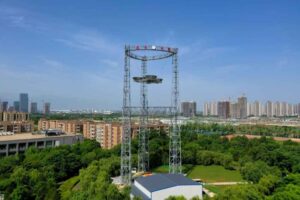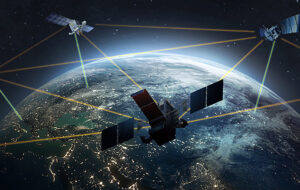Chinese university completes space-based solar power ground test facility
Tuesday, 14 June 2022 07:14
China's Xidian University has completed what it calls the world’s first full-link and full-system ground test system for space-based solar power.
Space takes centre stage at VivaTech
Tuesday, 14 June 2022 07:12
How does ESA enable the European space industry to prosper in the global market? People attending this week’s VivaTech show in Paris – which will showcase how innovation and technology can build a more sustainable and inclusive society – will discover how.
BlueHalo wins $11 million Air Force contract for laser communications terminals
Tuesday, 14 June 2022 06:07
BlueHalo won an $11 million contract from AFRL to develop a pair of optical laser communications terminals and a ground station.
The post BlueHalo wins $11 million Air Force contract for laser communications terminals appeared first on SpaceNews.
Air Force scientist takes over as director of Space Force rapid procurement agency
Tuesday, 14 June 2022 05:11
Former AFRL directed energy director Kelly Hammett on June 6, 2022, took over as head of the Space Rapid Capabilities Office
The post Air Force scientist takes over as director of Space Force rapid procurement agency appeared first on SpaceNews.
Okapi:Orbits raises 5.5 million euros in seed funding round
Monday, 13 June 2022 22:57
Germany startup Okapi: Orbits raised 5.5 million euros ($5.7 million) in a seed funding round led by Munich Re Ventures with participation from Dolby Family Ventures, Herius Capital and APEX Ventures.
The post Okapi:Orbits raises 5.5 million euros in seed funding round appeared first on SpaceNews.
Okapi:Orbits raises $5.7 million in seed funding round
Monday, 13 June 2022 22:57
Germany startup Okapi: Orbits raised 5.5 million euros ($5.7 million) in a seed funding round led by Munich Re Ventures with participation from Dolby Family Ventures, Herius Capital and APEX Ventures.
The post Okapi:Orbits raises $5.7 million in seed funding round appeared first on SpaceNews.
Astra rocket fails to deliver 2 small satellites after launch, NASA says
Monday, 13 June 2022 22:53 NASA said a rocket carrying two small weather satellites failed Sunday, preventing the inauguration of a technology that would have helped better forecast hurricanes.
The rocket by California-based Astra lifted off from Florida's Cape Canaveral Space Force Station, but the rocket's second stage malfunctioned before reaching orbit and lost the shoebox-sized technology.
"After a nomina
NASA said a rocket carrying two small weather satellites failed Sunday, preventing the inauguration of a technology that would have helped better forecast hurricanes.
The rocket by California-based Astra lifted off from Florida's Cape Canaveral Space Force Station, but the rocket's second stage malfunctioned before reaching orbit and lost the shoebox-sized technology.
"After a nomina Sun-like star identified in the region where the Wow! Signal originated
Monday, 13 June 2022 22:53 On May 6, the International Journal of Astrobiology of Cambridge University Press published a paper titled 'An approximation to determine the source of the Wow! Signal', authored by Alberto Caballero, a Spanish astronomer and science communicator.
Caballero decided to search through a catalog of stars from the European Space Agency's Gaia satellite to look for possible candidates.
He iden
On May 6, the International Journal of Astrobiology of Cambridge University Press published a paper titled 'An approximation to determine the source of the Wow! Signal', authored by Alberto Caballero, a Spanish astronomer and science communicator.
Caballero decided to search through a catalog of stars from the European Space Agency's Gaia satellite to look for possible candidates.
He iden New clues suggest how Hot Jupiters form
Monday, 13 June 2022 22:53 Since the first hot Jupiter was discovered in 1995, astronomers have been trying to figure out how the searing-hot exoplanets formed and arrived in their extreme orbits. Johns Hopkins University astronomers have found a way to determine the relative age of hot Jupiters using new measurements from the Gaia spacecraft, which is tracking more than a billion stars.
Lead author Jacob Hamer, a P
Since the first hot Jupiter was discovered in 1995, astronomers have been trying to figure out how the searing-hot exoplanets formed and arrived in their extreme orbits. Johns Hopkins University astronomers have found a way to determine the relative age of hot Jupiters using new measurements from the Gaia spacecraft, which is tracking more than a billion stars.
Lead author Jacob Hamer, a P Probing high-energy neutrinos with an IceCube
Monday, 13 June 2022 22:53 The subatomic particles called neutrinos, are believed to be ubiquitous throughout the Universe but are very difficult to detect. Now, Moroccan astrophysicist Salah Eddine Ennadifi and his co-workers, published a paper in EPJ Plus that describes the first known observation of intergalactic, high-energy neutrinos and probes new neutrino-related physics beyond the Standard Model of Particle Physic
The subatomic particles called neutrinos, are believed to be ubiquitous throughout the Universe but are very difficult to detect. Now, Moroccan astrophysicist Salah Eddine Ennadifi and his co-workers, published a paper in EPJ Plus that describes the first known observation of intergalactic, high-energy neutrinos and probes new neutrino-related physics beyond the Standard Model of Particle Physic Millisecond Pulsars can explain the Gamma-ray Excess in the Milky Way center
Monday, 13 June 2022 22:53 Old and fast spinning neutron stars called millisecond pulsars could be responsible for an unexplained signal from the center of our Milky Way, reports a team of astrophysicists in a new study published in Nature Astronomy.
Back in 2009, gamma-ray data from the Fermi-Large Area Telescope revealed an unexplained, apparently diffuse, signal from the center of the Milky Way. The origin of thi
Old and fast spinning neutron stars called millisecond pulsars could be responsible for an unexplained signal from the center of our Milky Way, reports a team of astrophysicists in a new study published in Nature Astronomy.
Back in 2009, gamma-ray data from the Fermi-Large Area Telescope revealed an unexplained, apparently diffuse, signal from the center of the Milky Way. The origin of thi Tracing The Remnants Of Andromeda's Violent History
Monday, 13 June 2022 22:53 A detailed analysis of the composition and motion of more than 500 stars revealed conclusive evidence of ancient a collision between Andromeda and a neighboring galaxy. The findings, which improve our understanding of the events that shape galaxy evolution, were presented by Carnegie's Ivanna Escala Monday at the meeting of the American Astronomical Society.
Galaxies grow by accreting mate
A detailed analysis of the composition and motion of more than 500 stars revealed conclusive evidence of ancient a collision between Andromeda and a neighboring galaxy. The findings, which improve our understanding of the events that shape galaxy evolution, were presented by Carnegie's Ivanna Escala Monday at the meeting of the American Astronomical Society.
Galaxies grow by accreting mate ESA centre to develop Europe's space economy and promote commercialisation
Monday, 13 June 2022 22:53 Entrepreneurs, fledgling firms and established space companies are to receive a boost with the launch of the European Centre for Space Economy and Commerce.
The ESA centre aims to create jobs and prosperity in Europe by fostering a fertile environment to promote the development of the space economy and boost the commercialisation of space in Europe. It will encourage disruptive innovation
Entrepreneurs, fledgling firms and established space companies are to receive a boost with the launch of the European Centre for Space Economy and Commerce.
The ESA centre aims to create jobs and prosperity in Europe by fostering a fertile environment to promote the development of the space economy and boost the commercialisation of space in Europe. It will encourage disruptive innovation AST SpaceMobile to launch BlueWalker 3 for Direct-to-Cell Phone Connectivity Testing
Monday, 13 June 2022 22:53 AST SpaceMobile, Inc. (NASDAQ: ASTS) has confirmed it plans to launch its BlueWalker 3 test satellite from Cape Canaveral, FL during the week of August 15, 2022.
The actual launch date remains subject to change and is contingent on a number of factors including, but not limited to, final testing, final integration, ground transport, timely readiness of the launch vehicle and other unknowns
AST SpaceMobile, Inc. (NASDAQ: ASTS) has confirmed it plans to launch its BlueWalker 3 test satellite from Cape Canaveral, FL during the week of August 15, 2022.
The actual launch date remains subject to change and is contingent on a number of factors including, but not limited to, final testing, final integration, ground transport, timely readiness of the launch vehicle and other unknowns Momentus First Demonstration Mission Update #3
Monday, 13 June 2022 22:53 Momentus Inc. (NASDAQ: MNTS) has provided its third Mission Update since the launch of its Vigoride-3 spacecraft on May 25.
As we previously stated in earlier updates on the inaugural flight of the Vigoride orbital transfer vehicle, the spacecraft experienced anomalies after its launch on May 25. Since that time, we have continued work to address the anomalies and identify root causes. Of
Momentus Inc. (NASDAQ: MNTS) has provided its third Mission Update since the launch of its Vigoride-3 spacecraft on May 25.
As we previously stated in earlier updates on the inaugural flight of the Vigoride orbital transfer vehicle, the spacecraft experienced anomalies after its launch on May 25. Since that time, we have continued work to address the anomalies and identify root causes. Of 
